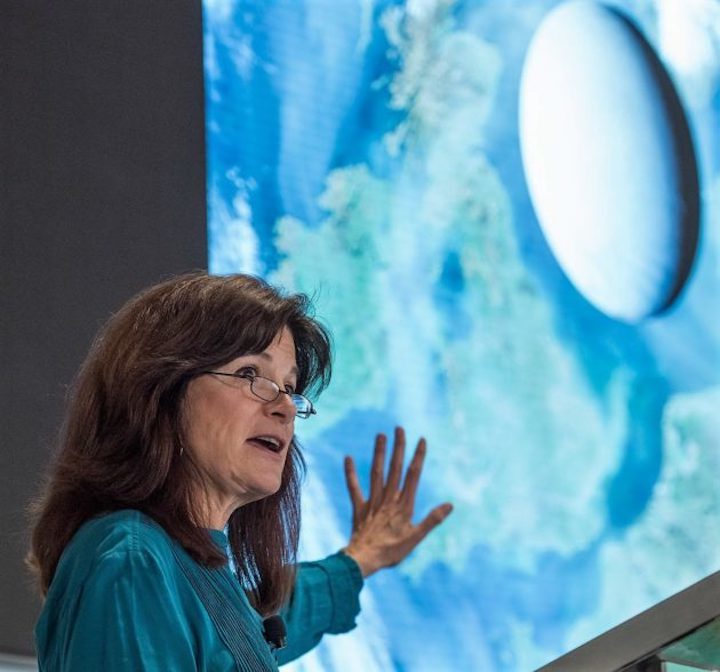15.04.2018

STANFORD, Calif. — Are there microbes falling in the snows of Enceladus? Could a drone fly to biological hot spots on Titan? Is life floating in the sulfurous clouds of Venus?
All those extraterrestrial locales — plus Mars and Europa — had their turn in the spotlight on Thursday at the third annual Breakthrough Discuss conference on Stanford University’s campus. The gathering was organized by the Breakthrough Initiatives, a program created by Russian billionaire Yuri Milner and his wife Julia to spotlight future frontiers in the search for life beyond Earth.
The program is supporting the radio-based search for extraterrestrial intelligence, or SETI, through Breakthrough Listen. It’s also backing Breakthrough Starshot, a decades-long campaign aimed at sending blizzards of beam-powered nanoprobes to the Alpha Centauri star system.
This week’s proceedings signal that Breakthrough’s quest will focus broadly on our own solar system as well.
During a conference conducted last November in Seattle, Milner said he was funding a feasibility study for a future mission to Enceladus, an ice-covered moon of Saturn that has plumes of water spraying out from a series of fissures. Evidence gathered during NASA’s recently concluded Cassini mission has led scientists to suspect that an ocean hidden beneath the ice could harbor life.
At this week’s gathering, the head of the Cassini imaging team, Carolyn Porco of the Space Science Institute, laid out her case for sending a probe back to Enceladus for a closer look.
Porco argued that Enceladus would be the best possible choice for seeking a second instance of the origin of life in the solar system — a “second genesis” that would be unmistakably distinct from the potential microbe-swapping between Earth and Mars.
If microbial life exists deep within Enceladus’ hidden ocean, it’s likely to be spewed into space along with the water droplets coming from the moon’s fissures. Those microbes should fall back onto the surface when the droplets freeze into what are basically snowflakes.
Last year, Porco and her colleagues estimated that a lander could collect millions of microbes for analysis, if they existed in the same concentration that’s found around Earth’s deep-ocean hydrothermal vents.
“Look up and stick your tongue out, and you’ve got what you came for,” Porco joked.
If a lander is too expensive, a probe could collect samples for onboard analysis as it flies through Enceladus’ plumes of water, she said.
Saturn’s largest moon, Titan, offers a different type of target in the search for life. The Cassini orbiter and a piggyback probe known as Huygens documented lakes of liquid hydrocarbons as well as evidence for a subsurface water ocean.
“It’s essentially a prebiotic laboratory on a planetary scale,” said Morgan Cable, a research scientist at NASA’s Jet Propulsion Laboratory.
Cable is on the science team for a mission that proposes sampling Titan’s surface, using an instrument-laden, hybrid lander-drone known as Dragonfly. If NASA selects Dragonfly for further funding, the rotorcraft could launch in 2025, touch down on Titan in 2034 and spend two years hopping between sample sites.
“We know we can do this,” Cable said. “Let’s do it.”
David Grinspoon, senior scientist at the Planetary Science Institute, put in a pitch for Venus — which has long been written off as a hellish planet unsuitable for life. Recently, however, Grinspoon and other researchers have revived the idea that sulfur-based organisms could live in temperate layers of Venus’ cloud cover.
“Among the plausible niches for extraterrestrial life in our solar system, the clouds of Venus are among the most accessible and the least well explained,” Grinspoon said.
One concept calls for sending a buoyant air vehicle known as the Venus Atmospheric Maneuverable Platform to float among the clouds and analyze samples.
For more than four decades, NASA has targeted Mars with robotic missions, including a rover that’s due to be launched in 2020. Carol Stoker, a planetary scientist at NASA’s Ames Research Center, wants to see another mission added to the list.
She pointed out that the Phoenix Mars Lander actually dug into deposits of water icein the Red Planet’s north polar region back in 2008.
“We should go back to the Phoenix landing site, and we should drill, and we should sample that ice to detect life, for an exploration that has a fairly good probability of getting a yes-no answer,” Stoker said.
JPL planetary geologist Cynthia Phillips’ vote goes to Europa — an ice-covered moon of Jupiter that, like Enceladus, is thought to harbor a watery ocean. Referring to the second-genesis hypothesis, Phillips said Europa presents “the best possible case for finding life beyond the Earth that didn’t come from the Earth.”
NASA has already committed to sending an orbiter known as the Europa Clipperpast the moon for multiple flybys in the 2020s, but Phillips and other Europa fans are also pressing for a lander mission that could scoop up icy samples for onsite analysis in the 2030s. NASA is already considering concepts for such a lander.
Which destinations will win out? Astrobiologists might wish the answer would be “all of the above,” but NASA has only so much funding available for robotic exploration.
Jim Green, who’s due to become NASA’s chief scientist, noted that all of the concepts mentioned during the Breakthrough Discuss sessions could be valid targets for space missions. For example, the concepts being considered for a Europa lander could provide templates for a potential Enceladus lander as well.
The cost question is where Milner and the Breakthrough Initiatives could play a role. Pete Worden, a former NASA official who leads the Breakthrough Initiatives, said support may be provided not only for a mission to Enceladus, but also for life-hunting missions to other promising solar system destinations.
Quelle: GeekWire
